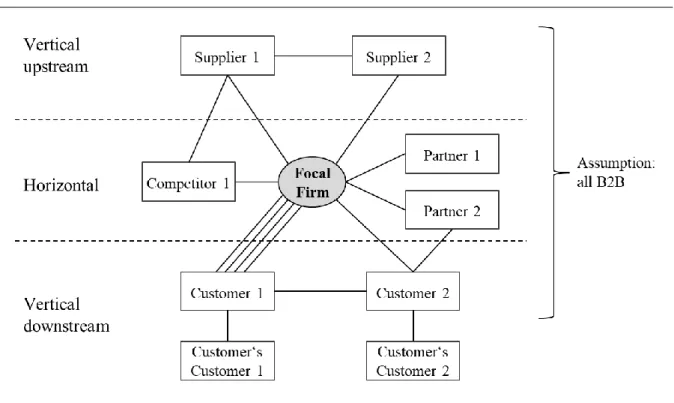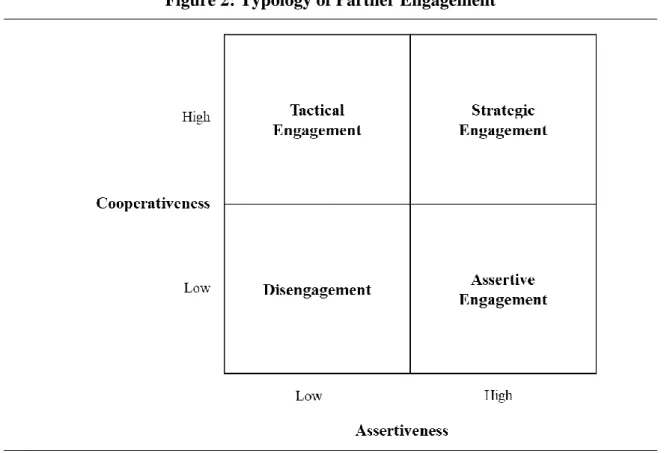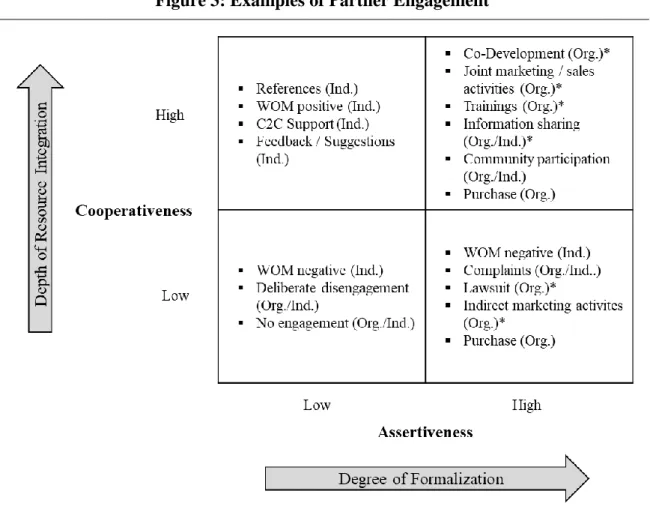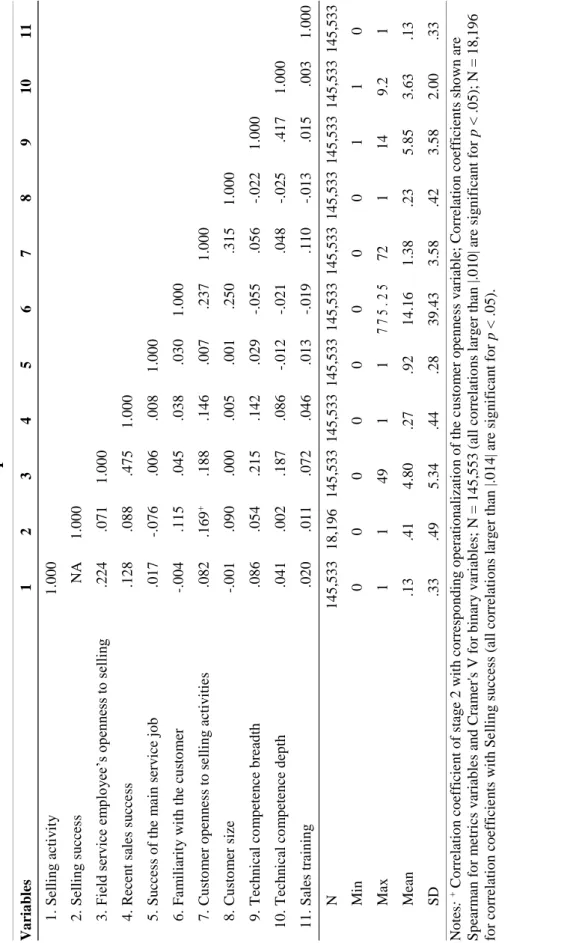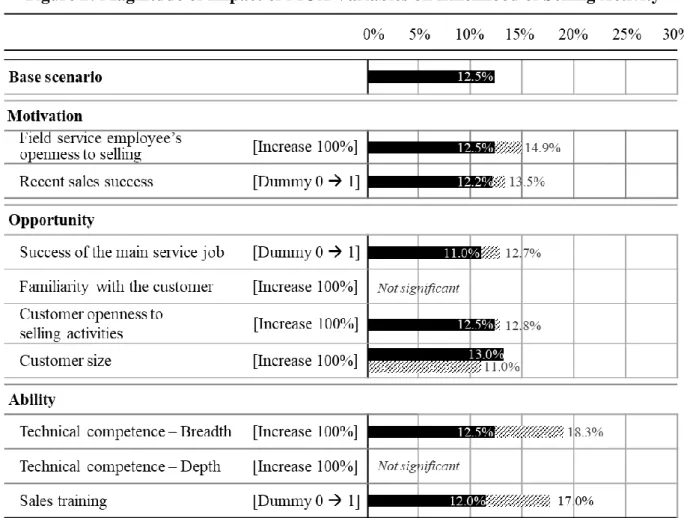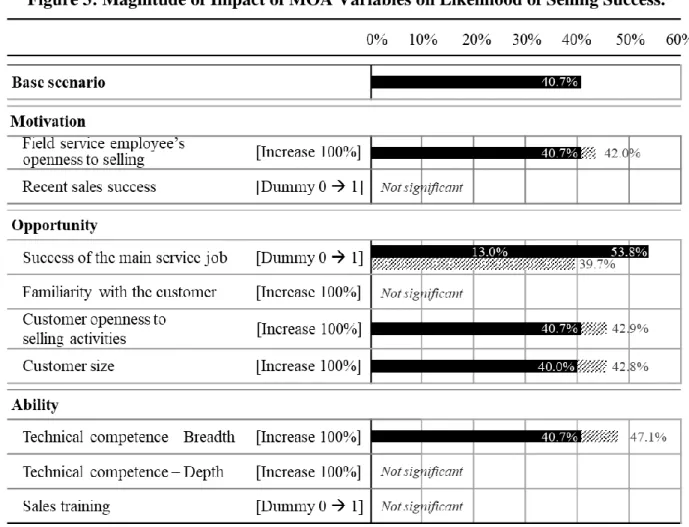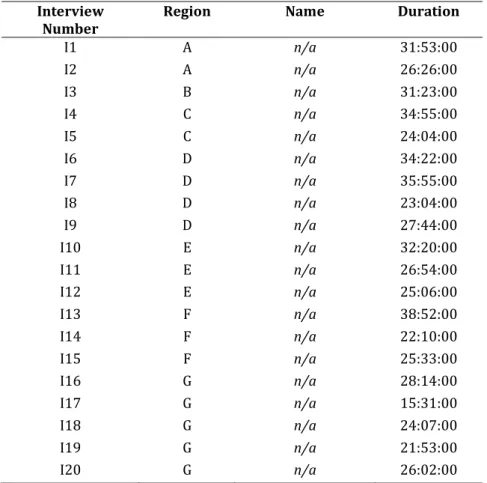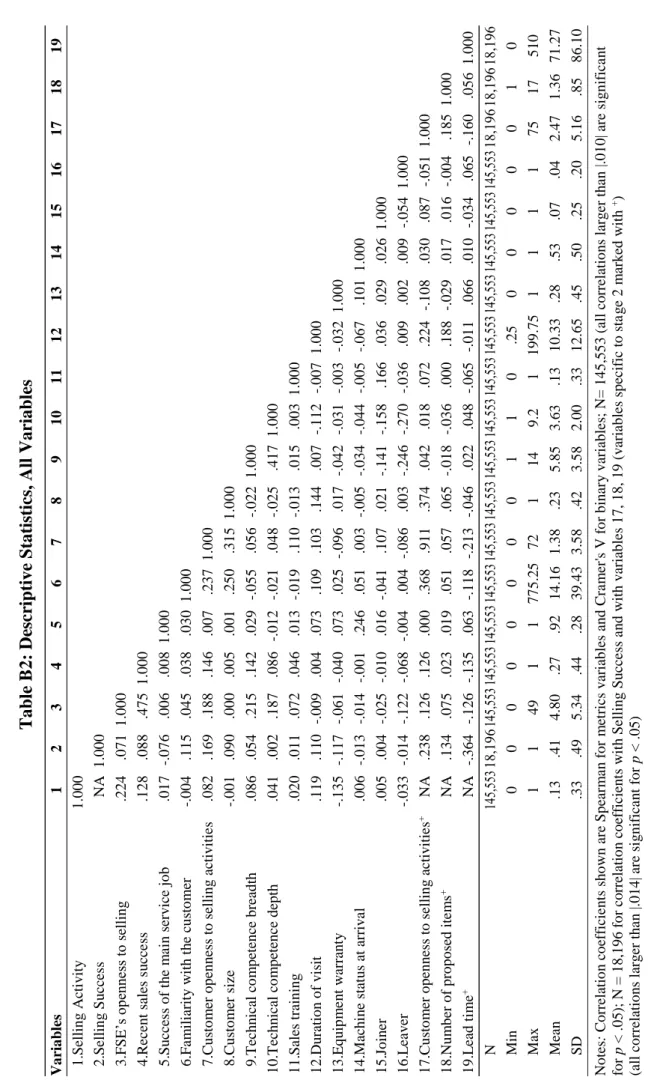ESSAYS ON CUSTOMER ENGAGEMENT STRATEGIES AND TACTICS
IN BUSINESS AND CONSUMER MARKETS
Inauguraldissertation zur
Erlangung des Doktorgrades der
Wirtschafts- und Sozialwissenschaftlichen Fakultät der
Universität zu Köln
2019
vorgelegt von
Dipl.-Kfm. Manuel Berkmann aus
Mannheim
To Luise, Nikolas & Romi, to my parents,
and to those who accompanied me in my discovery of marketing science.
Referent: Prof. Dr. Werner Reinartz Korreferent: Prof. Dr. André Marchand Tag der Promotion : 30. Januar 2020
I
CONTENTS
LIST OF FIGURES ... IV LIST OF TABLES ... V
SYNOPSIS ... 1
2.1 Essay I: From Customer to Partner Engagement A Conceptualization and Typology of Engagement in B2B ... 5
2.2 Essay II: Leveraging B2B Field Service Employees as a “Second” Sales Force ... 6
2.3 Essay III: Zapping in TV Advertising The Role of (Non) Engaging Content ... 8
REFERENCES SYNOPSIS ... 10
ESSAY I:FROM CUSTOMER TO PARTNER ENGAGEMENT ACONCEPTUALIZATION AND TYPOLOGY OF ENGAGEMENT IN B2B ... 13
ABSTRACT ... 13
2.1 Specific Properties of B2B Markets and Their Implications for Engagement ... 17
2.2 From Customer Engagement to Partner Engagement ... 20
3.1 Overview of the Typology ... 26
3.2 Insights from the Typology ... 29
4.1 Summary ... 35
4.2 Managerial Implications ... 36
4.3 Avenues for Future Research ... 37
REFERENCES ESSAY I ... 39
ESSAY II: LEVERAGING B2BFIELD SERVICE EMPLOYEES AS A “SECOND” SALES FORCE ... 45
ABSTRACT ... 45
2.1 Previous Literature ... 49
2.2 MOA Framework and Selling by Field Service Employees ... 54
II
2.3 Motivation ... 57
2.4 Opportunity ... 60
2.5 Ability ... 65
3.1 Research Setting ... 68
3.2 The Service and Selling Process ... 69
3.3 Data Collection and Variable Operationalization ... 70
3.4 Model Specification and Estimation ... 74
4.1 Effects of MOA Factors ... 77
4.2 Robustness Checks ... 79
5.1 Managerial Implications ... 81
5.2 Theoretical Implications ... 85
5.3 Limitations and Future Research ... 87
REFERENCES ESSAY II ... 89
APPENDIX ESSAY II ... 93
REFERENCES APPENDIX ESSAY II ... 110
ESSAY III:ZAPPING IN TVADVERTISING –THE ROLE OF (NON)ENGAGING CONTENT ... 113
ABSTRACT ... 113
3.1 Content Drivers of Zapping ... 120
3.2 Brand and Category Contingencies ... 127
4.1 TV Viewing and Advertising Data ... 129
4.2 Ad Content Coding ... 131
4.3 Further Variables and Descriptive Statistics ... 136
6.1 Content Drivers of Zapping ... 140
6.2 Control Variables ... 143
6.3 Moderation Effects ... 145
6.4 Robustness Checks ... 148
III
7.1 Managerial Implications ... 150
7.2 Theoretical Implications ... 155
7.3 Limitations and Future Research ... 157
REFERENCES ESSAY III ... 158
APPENDIX ESSAY III ... 163
REFERENCES APPENDIX ESSAY III ... 184 CURRICULUM VITAE ... VII
IV
LIST OF FIGURES SYNOPSIS
Figure 1: Conceptual Framework and Classification of Dissertation Projects ... 4
ESSAY I:FROM CUSTOMER TO PARTNER ENGAGEMENT ACONCEPTUALIZATION AND TYPOLOGY OF ENGAGEMENT IN B2B Figure 1: Graphical Illustration of a Network in Business Markets ... 21
Figure 2: Typology of Partner Engagement ... 27
Figure 3: Examples of Partner Engagement ... 30
ESSAY II:LEVERAGING B2BFIELD SERVICE EMPLOYEES AS A “SECOND”SALES FORCE Figure 1: Conceptual Framework ... 57
Figure 2: Magnitude of Impact of MOA Variables on Likelihood of Selling Activity ... 83
Figure 3: Magnitude of Impact of MOA Variables on Likelihood of Selling Success. ... 84
Figure 4: Incremental Revenue per Visit through Selling Activity (in % of Service Fees) .... 85
ESSAY III:ZAPPING IN TVADVERTISING THE ROLE OF (NON)ENGAGING CONTENT Figure 1: Conceptual Framework ... 121
Figure 2: Descriptive TV Viewing Patterns ... 131
Figure 3: Implication Matrix ... 154
Figure A1: Illustrative TV Spot for Emotionality ... 164
Figure A2: Illustrative TV Spot for Informativeness ... 164
Figure A3: Illustrative TV Spot for Creativity (Low) ... 164
Figure A4: Illustrative TV Spot for Creativity (High) ... 165
Figure A5: Illustrative TV Spot for Humor ... 165
Figure A6: Illustrative TV Spot for Branding ... 165
Figure D1: Distribution of Content Factors ... 169
V
LIST OF TABLES SYNOPSIS
Table 1: Overview of Dissertation Projects ... 2
ESSAY I:FROM CUSTOMER TO PARTNER ENGAGEMENT ACONCEPTUALIZATION AND TYPOLOGY OF ENGAGEMENT IN B2B Table 1: Overview of Types of Engagement with Exemplary Articles for the B2B Context .. 25
ESSAY II:LEVERAGING B2BFIELD SERVICE EMPLOYEES AS A “SECOND”SALES FORCE Table 1: Comparison of Field Service Employee and Sales Representative ... 50
Table 2: Summary of Related Literature and Contributions ... 52
Table 3: Overview of MOA Drivers of Selling Activity and Selling Success ... 56
Table 4: Descriptive Statistics ... 72
Table 5: Results ... 76
Table A1: Overview of Qualitative Interviews ... 95
Table A2: Derivation of Drivers of Selling Activity and Selling Success ... 96
Table A3: Overview of Drivers Not Considered in MOA Framework ... 99
Table B1: Operationalization of Control Variables ... 101
Table B2: Descriptive Statistics, All Variables ... 102
Table C1: Alternative Model Specifications ... 105
Table C2: Alternative Variable Operationalizations ... 106
Table D1: Modelling Training Participation ... 107
Table D2: Propensity Score Matching, Group Means Before and After Matching ... 108
Table D3: Propensity Score Matching, Results for Matched Sample ... 109
ESSAY III:ZAPPING IN TVADVERTISING THE ROLE OF (NON)ENGAGING CONTENT Table 1: Overview of Related Literature on Zapping ... 118
Table 2: Overview of Studies on Ad Content and Zapping ... 119
Table 3: Operationalization of Ad Content Variables ... 133
Table 4: Results Principal Component Analysis ... 135
Table 5: Descriptive Statistics and Correlations of Content Factors ... 136
Table 6: Results ... 141
Table 7: Results, Moderation ... 145
Table 8: Summary of Results and Managerial Implications ... 151
Table B1: Sample Demographics ... 167
Table D1: Operationalization of Control Variables ... 170
Table D2: Correlation Table and Descriptive Statistics for All Variables ... 171
Table D3: Correlation Matrix for All Content Elements ... 172
VI
Table D4: Ad Position Choice Across Brands ... 173
Table D5: Variance Inflation Factors ... 174
Table E1: Results Moderation Analysis (Details) ... 177
Table E2: Results Alternative Model Specifications ... 178
Table E3: Results Aggregated Sample ... 179
Table E4: Results for Specific Subsamples ... 180
Table E5: Results Alternative Variable Operationalizations ... 181
Table E6: Results Alternative Content Cues ... 182
Table E7: Drivers of Content Factors ... 183
1
SYNOPSIS Introduction
In the last decade, customer engagement has become a key topic for both practitioners and researchers (Forbes 2015; Kumar et al. 2010; Pansari and Kumar 2017; Vivek, Beatty, and Morgan 2012). A recent study by McKinsey & Company, for example, shows that 69% of CEOs consider customer engagement a top strategic priority for their business (McKinsey 2014). On the other hand, only 25% of CMOs state that they have a comprehensive understanding of the phenomenon customer engagement (CMO Council 2014). This is particularly critical because customer engagement has a considerable effect on profits (Kumar and Pansari 2016).
Thus, it is not surprising that customer engagement also remains a “hot topic“ in academia and one of the top MSI research priorities (2010, 2014, 2016). Classically, customer engagement deals with customer behavior beyond purchase and thus non-monetary contributions by the customer (e.g., van Doorn et al. 2010), such as Word-of-Mouth (WOM), feedback and online reviews, or participation in the innovation process. However, customer engagement also pertains to mental engagement with a brand and thus focuses on experiences at specific touchpoints, such as the exposure to an advertising or the interaction with the firm’s frontline employees (e.g., Brodie et al. 2011; Malthouse and Calder 2011). There is a general agreement that customer engagement is a multidimensional concept (Beckers, Risselada, and Verhoef 2014) comprising affective, attitudinal, and behavioral components. Thus, for the scope of this dissertation, it is defined as “the mechanics of a customer’s value addition to the firm, either through direct or/and indirect contribution” (Pansari and Kumar 2017, p. 2).
While previous literature largely focused on the conceptualization of customer engagement (e.g., Brodie et al. 2011; van Doorn et al. 2010; Pansari and Kumar 2017), only a few studies have investigated how managers can actually stimulate and/or facilitate customer
2
engagement (e.g., Eisingerich et al. 2019; Godes and Mayzlin 2009; Harmeling et al. 2017).
However, the latter is of high importance since only a few customers are truly engaged (Libai 2011) and it is often left to the firm to take the initiative to engage the customer (Vivek, Beatty, and Morgan 2012). Thus, marketers need to understand how to design and successfully implement customer engagement initiatives.
Accordingly, this dissertation investigates customer engagement strategies and tactics.
While customer engagement strategy pertains to the overarching plan to leverage customer engagement to achieve the firm’s goals, customer engagement tactics deal with single actions taken by the firm to facilitate customer engagement across the various touchpoints in the customer journey. Specifically, this dissertation includes three essays, each addressing distinct questions with respect to customer engagement over the customer journey. Table 1 presents an overview of the three essays including author and publication-status information.
Table 1: Overview of Dissertation Projects
Essay Title Author(s) Status
I From Customer to Partner
Engagement A Conceptualization and Typology of Engagement in B2B
Werner Reinartz and Manuel Berkmann
Published in Customer Engagement
Marketing (eds. R.
Palmatier, V. Kumar, and C. Harmeling) II Leveraging B2B Field Service
Employees as a “Second” Sales Force
Manuel Berkmann, Maik Eisenbeiß, and Werner Reinartz
Under review (1st round): Journal of Marketing
III Zapping in TV Advertising The Role of (Non) Engaging Content
Manuel Berkmann, Maren Becker, and Werner Reinartz
Prepared to submit to:
Journal of Marketing Research
Note: Being the lead author of essay II and III, Manuel Berkmann contributed significantly to each one of them (idea generation, conceptualization, data collection, analysis, and write-up). Also for essay I, Manuel Berkmann made a significant contribution, in particular in terms of literature analysis, conceptualization, and write-up.
The first essay is conceptual in nature and deals with a strategic analysis of customer engagement in business markets, whereas the second and third essay are empirical and
3
investigate two specific customer engagement tactics: the new role of field service employees as customer engagement facilitators in business-to-business (B2B) markets and the role of (non) engaging content in advertising in business-to-consumer (B2C) markets.
Specifically, the first essay of this dissertation titled “From Customer to Partner Engagement A Conceptualization and Typology of Engagement in B2B”, co-authored by Werner Reinartz and Manuel Berkmann, provides an analysis of the strategic relevance of customer engagement in business-to-business markets. It analyzes a number of specific properties of business markets (e.g. the derived character of demand or the formalization of exchange) and discusses their implications for the phenomenon of customer engagement.
Furthermore, the authors argue that the concept of customer engagement should be extended to partner engagement in order to reflect the complexity and network character of value chains in business markets. Finally, the authors develop a typology of partner engagement behaviors in business markets covering all stages of the customer journey. Thus, this research paper provides a contribution to the marketing literature by conceptualizing the customer engagement phenomenon for the B2B context and analyzing the strategic implications for managers.
The second essay, titled “Leveraging B2B Field Service Employees as a ‘Second’ Sales Force” and co-authored by Manuel Berkmann, Maik Eisenbeiß, and Werner Reinartz, deals with technical field service employees that engage in selling activities in addition to their main service job. In this study, the authors investigate a recent development among industrial equipment manufacturers to employ the field service force for cross- and up-selling. Thus, they leverage the service touchpoints as opportunities to engage customers in the post-purchase phase. This represents a tactical activity to pro-actively manage the installed base and strengthen existing customer relationships. The authors employ a unique longitudinal dataset obtained from a major global industrial company, consisting of more than 140,000 customer visits of field service employees over a period of four years and more than 18,000 selling
4
activities initiated during the service visits. Drawing on the Motivation-Opportunity-Ability (MOA) framework, the authors identify a number of drivers for the industrial B2B context (e.g., success of the service job, technical competence of the field service employee, or customer openness) and investigate their impact on selling activity and selling success.
Finally, the third essay, titled “Zapping in TV Advertising The Role of (Non) Engaging Content” and co-authored by Manuel Berkmann, Maren Becker, and Werner Reinartz, investigates how marketers can use executional content cues in their TV advertisings (e.g., informativeness, creativity, or branding) to engage consumers and mitigate zapping behavior.
To this end, advertising content functions as a means to mentally transport the consumer into the narrative (Malthouse and Calder 2011; Wang and Calder 2006, 2009). The authors develop a conceptual framework linking multiple content factors to psychological responses and zapping behavior. They test this content-zapping relationship by drawing on a unique multi- source dataset of individual zapping behavior of more than 2,500 German television viewers combined with advertising data and content information for 1,315 spots representing 308 brands from 96 categories. Figure 1 provides an overview of the three research projects and structures them along the customer journey and level of managerial action. The next section summarizes motivation, research objectives, main results, and implications of each essay.
Figure 1: Conceptual Framework and Classification of Dissertation Projects
5 Summary of Dissertation Projects
2.1 Essay I: From Customer to Partner Engagement A Conceptualization and Typology of Engagement in B2B
In the last decade, customer engagement has become a key topic for both practitioners and researchers. Reflecting the importance of customer engagement for managers, researchers have proposed several approaches to conceptualizing (e.g., Brodie et al. 2011; van Doorn et al.
2010) and measuring (e.g., Kumar and Pansari 2016; Vivek et al. 2014) customer engagement.
Moreover, initial studies have used customer engagement to explain consumer behavior in empirical applications (e.g., Eisingerich et al. 2019; Eisingerich, Auh, and Merlo 2014; Verleye, Gemmel, and Rangarajan 2014). Yet, looking at the extant literature, it becomes apparent that the focus is almost exclusively on customer engagement in business-to-consumer (B2C) settings while business-to-business (B2B) settings have largely been neglected (Vivek, Dalela, and Beatty 2016). Thus, the question arises to what extent customer engagement matters in the B2B context and how B2B managers should deal with the new phenomenon.
Following the call for more B2B specific research (Lilien 2016), in the first essay, the authors aim at addressing the void in the engagement literature and focus on a conceptualization of engagement in the domain of B2B relationships. Specifically, the authors review specific properties of B2B markets (e.g., the derived character of demand, the multi-person nature of the buying process, the high degree of interaction, the formalization / rationality of exchange, or the small number of players in the market) and discuss their implications for engagement.
One finding, for example, is that engagement in business markets needs to be assessed within a broader context of a firm’s network considering both horizontal and vertical relationships.
Another finding is that there are more “natural” opportunities in business markets to get engaged. Collectively, the implications of the properties indicate that there are specific aspects to the concept of engagement in business markets that warrant a dedicated investigation.
6
Based on the findings, the authors argue that the concept of customer engagement should be extended to partner engagement in order to reflect the complexity and network character of value chains in business markets. It is, thus, a generalization of the customer engagement concept that applies to both horizontal and vertical relationships as well as direct and indirect partners in the business network. Building on this conceptualization, the authors propose a novel definition of partner engagement as a partner’s volitional behavior towards any other stakeholder in the value chain affecting the focal firm’s business, including both direct (purchase related) but mainly indirect (referral, influence, knowledge) behaviors.
To provide guidance for B2B managers, the paper presents an overview of the most relevant partner engagement behaviors. For that, the authors develop a typology of B2B partner engagement that builds on two dimensions: The dimension assertiveness relates to a partner’s focus on its own outcomes, while cooperativeness as the second dimension relates to the level to which the partner attempts to satisfy the other party’s concerns. Using the typology, the authors classify the various types of B2B partner engagement as either “Disengagement”,
“Tactical Engagement”, “Assertive Engagement”, or “Strategic Engagement” and discuss the conditions and consequences of each engagement class. In addition to managerial implications, the paper also proposes avenues for future research on customer / partner engagement in B2B.
2.2 Essay II: Leveraging B2B Field Service Employees as a “Second” Sales Force Field service employees play an important role in the customer management of industrial companies. In addition to their regular tasks of maintaining and repairing equipment, they assume many important functions (Rapp et al. 2015; Ulaga and Reinartz 2011): They are the supplier’s face to the customer, act as problem solvers and relationship managers, collect valuable customer information and often identify important sales opportunities. As such, they are critical boundary spanners into the client firm. Recently, B2B managers have started to leverage these service touchpoints as additional opportunities to engage customers in the post-
7
purchase phase. This pertains to pro-active education, feedback seeking, or prevention (Challagalla, Venkatesh, and Kohli 2009) but also to selling activities. However, field service employees face a number of challenges to successful selling. Most importantly, selling as a new tactical engagement activity may be at odds to the regular service job. Thus, it is of utmost importance for managers to understand how they can leverage field service employees effectively as a “second” sales force.
To address this question, the authors develop a comprehensive conceptual framework to explain field service employees’ selling behavior. For that, they conduct a qualitative study consisting of multiple interviews with field service employees to identify relevant drivers of selling activity and selling success (e.g., success of the service job, technical competence of the field service employee, or customer openness) and structure them along the established Motivation-Opportunity-Ability (MOA) framework (e.g., Sabnis et al. 2013).
For the empirical analysis, the authors draw on a unique secondary dataset from a cooperating global industrial company that sells high-tech manufacturing equipment in combination with industrial services. This dataset consists of cross-sectional and longitudinal data from the field service organization covering more than 140,000 service visits of 420 field service employees over a period of four years (2012–2015) in combination with data on more than 18,000 selling activities initiated during the service visits. To assess the impact of the different MOA dimensions, the authors estimate two logit panel models with random effects – one to explain field service employees’ selling activity (i.e., engagement-inducing behavior) and one to explain selling success (i.e., engagement success).
The results reveal several interesting findings, in particular that factors specific to the industrial service context are key antecedents to the field service employees’ selling behavior.
For example, the field service employee’s success in restoring operability of equipment increases the likelihood of selling activity but decreases the chances of its success. Further,
8
generalists with broad technical competence (compared to specialists with deep technical competence) are more likely to engage in selling activities and more likely to convert these activities into sales. In addition, consistent with previous conceptual research (Challagalla, Venkatesh, and Kohli 2009), customer expertise is an important determinant of both selling activity and selling success. Results of a simulation demonstrate the revenue-generating potential of field service employees engaging in tactical selling: Selling activities increase the revenue per visit by 20% with significantly stronger lifts for specific constellations. The paper, thus, provides actionable insights for B2B managers how to leverage field service employees as a “second” sales force.
2.3 Essay III: Zapping in TV Advertising The Role of (Non) Engaging Content TV advertising remains a key pillar in the communication mix of many brands and constitutes an important touchpoint to foster consumer engagement with the brand. However, to be effective advertising needs exposure. Thus, one of the main reasons for low advertising effectiveness is the consumers’ conscious avoidance of ads (Tellis 2004). When consumers avoid an ad by leaving the room or zapping, advertisers lose the ability to communicate their brand message and the investment is lost. It is, thus, crucial for advertisers to understand which factors influence the avoidance of advertising, i.e. zapping.
Specifically, the third essay focuses on the role of advertising content as the vehicle to engage consumers. That is, by creating engaging advertising content marketers may succeed in drawing consumers into the narrative (Malthouse and Calder 2011; Wang and Calder 2006, 2009) and thus mitigate zapping. The role of content thus far has only been investigated in lab studies. These studies found indicative evidence that content affects zapping. Although this stream of research has contributed a great deal of insight, there is still limited understanding of the boundary conditions and to what extent these findings also hold for zapping behavior outside of the lab, i.e., in the real world. Being the first to investigate the relationship between
9
advertising content and zapping in the field, this study aims to provide marketing managers with actionable implications on how to create engaging content for their ads.
To do so, the authors develop a conceptual framework linking five important and frequently employed content factors (emotionality, informativeness, creativity, humor, and branding) to psychological responses and zapping behavior. They test the content-zapping relationship by drawing on a unique multi-source dataset from a German TV broadcaster.
Specifically, this dataset comprises individual level viewing information for a panel of more than 2,500 individuals for one major entertainment format over a period of three months in 2016. The authors combine this data with content information for a total of 1,315 ads obtained via expert coding. In this procedure, five experts coded 20 executional content cues, which were subsequently condensed into six content factors using principal component analysis. To investigate the effect of the content factors on the zapping behavior, a binary logit model with brand and individual fixed effects is estimated.
Results show that ad content indeed influences zapping behavior in the field – even when controlling for a large number of context variables (e.g., position) and including brand and individual fixed effects. This implies that some – not all – content factors can be an effective tool to engage viewers and mitigate zapping. Specifically, the findings show that creativity and late brand timing in ads are associated with less zapping, whereas informativeness and a strong brand presence are associated with more zapping. Moreover, the authors show that the influence of content on zapping differs between more and less familiar brands as well as between search and experience categories. The paper, thus, provides managers with actionable findings that they can apply given their specific situation.
10
REFERENCES SYNOPSIS
Beckers, Sander F.M., Hans Risselada, and Peter C. Verhoef (2014), “Customer Engagement:
A New Frontier in Customer Value Management,” in Handbook of Service Marketing Research, R. T. Rust and M.-H. Huang, eds., Northhampton, MA: Edward Elgar, 97–
122.
Brodie, Roderick J., Linda D. Hollebeek, Biljana Juric, and Ana Ilic (2011), “Customer Engagement: Conceptual Domain, Fundamental Propositions, and Implications for Research,” Journal of Service Research, 14(3), 252–71.
Challagalla, Goutam, R. Venkatesh, and Ajay K. Kohli (2009), “Proactive Postsales Service:
When and Why Does It Pay Off?,” Journal of Marketing, 73(2), 70–87.
CMO Council (2014), “Maximize How You Individualize: Map the Operational Gap in Customer Insight and Experience,” (accessed October 9, 2019), [available at https://www.cmocouncil.org/thought-leadership/reports/maximize-how-you- individualize].
van Doorn, Jenny, Katherine N. Lemon, Vikas Mittal, Stephan Nass, Doréen Pick, Peter Pirner, and Peter C. Verhoef (2010), “Customer Engagement Behavior: Theoretical Foundations and Research Directions,” Journal of Service Research, 13(3), 253–66.
Eisingerich, Andreas B., Seigyoung Auh, and Omar Merlo (2014), “Acta Non Verba? The Role of Customer Participation and Word of Mouth in the Relationship Between Service Firms’ Customer Satisfaction and Sales Performance,” Journal of Service Research, 17(1), 40–53.
Eisingerich, Andreas B., André Marchand, Martin P. Fritze, and Lin Dong (2019), “Hook vs.
Hope: How to Enhance Customer Engagement Through Gamification,” International Journal of Research in Marketing, 36(2), 200–215.
Forbes (2015), “Customer Engagement: Best of the Best,” Forbes Insights, (accessed October 9, 2019), [available at https://images.forbes.com/forbesinsights/StudyPDFs/
SAP_Customer_Engagement-REPORT.pdf].
Godes, David, and Dina Mayzlin (2009), “Firm-Created Word-of-Mouth Communication:
Evidence from a Field Test,” Marketing Science, 28(4), 721–39.
Harmeling, Colleen M., Jordan W. Moffett, Mark J. Arnold, and Brad D. Carlson (2017),
“Toward a Theory of Customer Engagement Marketing,” Journal of Academy of Marketing Science, 45(3), 312–35.
Kumar, V., Lerzan Aksoy, Bas Donkers, Rajkumar Venkatesan, Thorsten Wiesel, and Sebastian Tillmanns (2010), “Undervalued or Overvalued Customers: Capturing Total Customer Engagement Value,” Journal of Service Research, 13(3), 297–310.
Kumar, V., and Anita Pansari (2016), “Competitive Advantage Through Engagement,”
Journal of Marketing Research, 53(4), 497–514.
Libai, Barak (2011), “The Perils of Focusing on Highly Engaged Customers,” Journal of
11 Service Research, 14(3), 275–76.
Lilien, Gary L. (2016), “The B2B Knowledge Gap,” International Journal of Research in Marketing, 33(3), 543–56.
Malthouse, Edward C., and Bobby J. Calder (2011), “Engagement and Experiences:
Comment on Brodie, Hollenbeek, Juric, and Ilic (2011),” Journal of Service Research, 14(3), 277–79.
McKinsey (2014), “The Digital Tipping Point: McKinsey Global Survey Results,” (accessed October 9, 2019), [available at http://www.mckinsey.com/business-functions/digital- mckinsey/our-insights/the-digital-tipping-point-mckinsey-global-survey-results].
MSI (2010), 2010-2012 Research Priorities, Boston, MA: Marketing Science Institute.
——— (2014), 2014-2016 Research Priorities, Boston, MA: Marketing Science Institute.
——— (2016), 2016-2018 Research Priorities, Boston, MA: Marketing Science Institute.
Pansari, Anita, and V. Kumar (2017), “Customer Engagement: The Construct, Antecedents, and Consequences,” Journal of the Academy of Marketing Science, 45(3), 294–311.
Rapp, Adam, Raj Agnihotri, Thomas L. Baker, and James M. Andzulis (2015), “Competitive Intelligence Collection and Use by Sales and Service Representatives: How Managers’
Recognition and Autonomy Moderate Individual Performance,” Journal of the Academy of Marketing Science, 43(3), 357–74.
Sabnis, Gaurav, Sharmila C. Chatterjee, Rajdeep Grewal, and Gary L. Lilien (2013), “The Sales Lead Black Hole: On Sales Reps’ Follow-Up of Marketing Leads,” Journal of Marketing, 77(1), 52–67.
Tellis, Gerard J. (2004), Effective Advertising: Understanding When, How, and Why Advertising Works, Thousand Oaks, CA: Sage.
Ulaga, Wolfgang, and Werner J. Reinartz (2011), “Hybrid Offerings: How Manufacturing Firms Combine Goods and Services Successfully,” Journal of Marketing, 75(6), 5–23.
Verleye, Katrien, Paul Gemmel, and Deva Rangarajan (2014), “Managing Engagement Behaviors in a Network of Customers and Stakeholders: Evidence From the Nursing Home Sector,” Journal of Service Research, 17(1), 68–84.
Vivek, Shiri D., Sharon E. Beatty, Vivek Dalela, and Robert M. Morgan (2014), “A
Generalized Multidimensional Scale for Measuring Customer Engagement,” Journal of Marketing Theory and Practice, 22(4), 401–20.
Vivek, Shiri D., Sharon E. Beatty, and Robert M. Morgan (2012), “Customer Engagement:
Exploring Customer Relationships Beyond Purchase,” Journal of Marketing Theory and Practice, 20(2), 122–46.
Vivek, Shiri D., Vivek Dalela, and Sharon E. Beatty (2016), “Partner Engagement: A
Perspective on B2B Engagement,” in Customer Engagement - Contemporary Issues and Challenges, R. J. Brodie, L. D. Hollebeek, and J. Conduit, eds., New York: Routledge,
12 53–66.
Wang, Jing, and Bobby J. Calder (2006), “Media Transportation and Advertising,” Journal of Consumer Research, 33(2), 151–62.
——— (2009), “Media Engagement and Advertising: Transportation, Matching, Transference and Intrusion,” Journal of Consumer Psychology, 19(3), 546–55.
13
ESSAY I: FROM CUSTOMER TO PARTNER ENGAGEMENT
ACONCEPTUALIZATION AND TYPOLOGY OF ENGAGEMENT IN B2B
Authors: Werner Reinartz and Manuel Berkmann
ABSTRACT
This chapter focuses on engagement in business-to-business contexts. It analyzes a number of specific properties of business markets (e.g. the derived character of demand or formalization / rationality of exchange) and discusses their implications for the phenomenon of customer engagement. Furthermore, the authors argue that the concept of customer engagement should be extended to partner engagement in order to reflect the complexity and network character of value chains in business markets. Finally, the authors develop a typology of partner engagement behaviors in business markets and discuss differences with respect to the level of engagement (organizational vs. individual), underlying relational factors as well as special cases. Based on the analysis, the authors derive specific implications for B2B managers and provide avenues for future research in the domain of partner engagement.
Keywords: Partner engagement, business-to-business, typology, business value chain, vertical and horizontal collaboration, properties of B2B markets, assertiveness,
cooperativeness
14 Introduction
In the last decade, customer engagement has become a key topic for both practitioners and researchers. For Forbes Insights, “engagement is everything” (2015, p. 3). The increasing importance in marketing practice gets support from a recent study by McKinsey & Company that shows that 69% of CEOs consider customer engagement a top strategic priority for their business (McKinsey 2014). On the other hand, only 25% of CMOs state that they have a comprehensive understanding of the phenomenon customer engagement (CMO Council 2014).
Also in marketing research, engagement is regarded as a top priority as indicated by continued representation in the MSI Research Priorities (2010, 2014, 2016).
In fact, there has been considerable progress in conceptualizing and measuring customer engagement (Brodie et al. 2011; van Doorn et al. 2010; Hollebeek, Srivastava, and Chen 2016;
Kumar and Pansari 2016; Pansari and Kumar 2017). While some studies define customer engagement as behavioral manifestations beyond purchase (van Doorn et al. 2010), others argue that customer engagement is rather a psychological state of mind (Brodie et al. 2011). There is a general agreement, however, that customer engagement is a multidimensional concept (Beckers, Risselada, and Verhoef 2014) which can be holistically defined as “the mechanics of a customer’s value addition to the firm, either through direct or/and indirect contribution”
(Pansari and Kumar 2017, p. 2). Yet, looking at the extant literature, it becomes apparent that the focus is almost exclusively on customer engagement in business-to-consumer (B2C) settings while business-to-business (B2B) settings have largely been neglected (Vivek, Dalela, and Beatty 2016).
This is surprising given the tremendous importance of customer engagement in B2B settings. The lead user concept introduced by von Hippel (1986) was one of the first descriptions of customer engagement and originates in B2B innovation research. It states that firms can improve their innovation efforts by involving selected customers whose “needs will become
15
general in a marketplace months or years in the future” (von Hippel 1986, p. 791). This approach is still valuable to B2B firms today. The software company SAP, for example, has implemented the lead user idea in the form of a Co-Innovation Lab intended to continuously gather insights from key clients and partners in order to leverage their innovation potential. As another instrument to foster collaboration with and among the many different partners (e.g.
users, developers, implementation partners, etc.) SAP hosts a Community Network with 2 million unique visitors a month (Carboni 2014).
In addition, two trends are expected to increase the relevance of engagement in business markets and thus warrant a thorough understanding of the phenomenon. First, the digitization provides opportunities for increasing interconnectedness among the players. As firms and their products and services become parts of broader systems (“Industry 4.0”), the need for system interoperability and collaboration increases (Porter and Heppelmann 2015). Second, we witness an ongoing de-verticalization of value chains. For example, in the automobile industry the value-added by OEMs like GM, Toyota or Volkswagen is projected to decrease from 44% in 1985 to 18% in 2015 (Statista 2016). The trend towards outsourcing and collaboration is also prevalent within the marketing function. Take for example the number and scope of players involved in digital marketing activities (internal marketing department, data provider, creative agency, publisher, ad networks, intermediaries for online shops, etc.), which has led to the creation of the role of lead agencies whose main responsibility is coordinating all players involved (Bauer et al. 2017). Both trends exemplify that firms no longer operate in environments with a limited number of partners. Rather, they are part of complex networks comprising suppliers, competitors, partners and customers. Thus, it is of utmost importance to understand how B2B players engage with each other in order to create value.
Despite the high relevance of engagement for business marketing practice, business marketing research on engagement in B2B is scarce. Except for the work of Vivek and
16
colleagues (2016), the conceptual literature on engagement has largely focused on consumer markets (Brodie et al. 2011; van Doorn et al. 2010). Following the call for more B2B specific research (Lilien 2016), we aim to address the void in the engagement literature and focus on a conceptualization of engagement in the domain of B2B relationships. Specifically, we seek to make the following contributions. First, we review specific properties of B2B markets and analyze their implications for engagement in business markets. Second, we suggest a broadening of perspective and an extended conceptualization of engagement in B2B. We propose to refer to this phenomenon as “partner engagement” instead of (just) “customer engagement”. By taking a holistic view of the network a firm operates in, we seek to generalize recent initial work on B2B engagement by Vivek and colleagues (2016) and try to fully capture the complexity of B2B settings. Third, we develop a typology of partner engagement by adopting a framework from the organizational behavior literature. Fourth, based on the typology, we discuss different types of engagement with respect to the level of engagement (organizational vs. individual), underlying relational factors and special cases that help understand and manage partner engagement. Finally, we suggest several avenues for future research in the domain of partner engagement in B2B.
A B2B Perspective on Engagement
Customer engagement is regarded as the new frontier in the domain of customer management and relationship marketing (Verhoef, Reinartz, and Krafft 2010). Taking a historical perspective, Beckers, Risselada and Verhoef (2014) describe a three stage development: Until the 1990s, marketing was focused on discrete transactions and one-way communication from the firm to the customer, e.g. by mass media advertising and direct mailings. The era of relationship marketing that followed (early 1990s to 2005) emphasized the importance of (two-way) firm-customer interaction and a joint value creation process. The current era of engagement is marked by a more holistic perspective, in which the classical firm-
17
customer dyad has been opened up and considers interactions with other stakeholders (e.g. other customers) as well.
Against this background it is notable that although relationship marketing originated in B2B marketing (e.g. Dwyer, Schurr, and Oh 1987), the literature on engagement today almost exclusively focuses on B2C settings. If we consider the almost similar economic weight of B2B and B2C transaction volumes in the global economy, one should expect similar levels of academic attention for engagement in both markets (Lilien 2016). Yet, there is a clear mismatch between the importance in practice and the representation in research. Is this due to the fact that there is no difference between B2B and B2C with respect to engagement? Or, alternatively, is engagement simply less relevant in B2B? On the contrary, we argue that the specific properties of B2B markets make the concept of engagement highly relevant and yield distinct implications for its understanding. Therefore, the next section is intended to establish an overall theoretical framework for engagement in B2B. For that, we discuss specific properties of B2B markets and derive implications for engagement in these markets.
2.1 Specific Properties of B2B Markets and Their Implications for Engagement
The key difference between business-to-business and business-to-consumer markets is the fact that in B2B settings organizations - and not the individual end consumer - act as decision makers and buyers. While many specific properties of B2B markets have been described in extant literature (e.g. Grewal and Lilien 2012; Lilien 2016), we will focus on five properties that are most relevant for the concept of engagement since they deal with relational aspects (Homburg, Kuester, and Krohmer 2013):
- The derived character of demand
- The multi-person nature of the buying process - The high degree of interaction
- The formalization / rationality of exchange
18 - The small number of players in the market
First, the derived character of demand (Grewal et al. 2015) implies that compared to consumers B2B buyers (only) purchase products and services to satisfy the needs of their respective customers. Thus, the demand of downstream partners in the value chain ultimately drives the behavior of firms in business markets. This requires a broader focus than just the focal firm-customer dyad and often entails approaches for marketing to the customers’
customers (Dahlquist and Griffith 2014; Homburg, Wilczek, and Hahn 2014). To add to the complexity, many firms collaborate with partners (e.g. consulting firms) or their own suppliers (e.g. special component manufacturers) in order to create value for their customers in a complex value chain system. This points to the importance of both a vertical and horizontal perspective and leads to the following implication for engagement in B2B1.
Implication 1: Engagement in business markets needs to be assessed within a broader context of a firm’s network considering both horizontal and vertical relationships.
The second important property of B2B is the multi-person nature of the buying process (Lilien and Wong 1984). While in consumer markets, the most complex setup for decision- making is a household, in B2B markets multiple functions and persons are involved in decision- making. The buying center concept, for example, describes five different roles (decision maker, gatekeeper, influencer, user, buyer) that should be considered when analyzing organizational decision making (Johnston and Bonoma 1981). Moreover, recent empirical research shows that relationship multiplexity is an important driver of firm performance. For example, multiple contacts at the individual level can help improve the value of supplier-customer relationships (Palmatier 2008). Thus, identifying those contacts within a partner’s buying center that have a
1 One could argue that upstream and horizontal B2B relationships are also relevant for firms in B2C markets (e.g.
banks, electronic equipment manufacturers, fashion). In that sense, firms marketing to the end consumer are a special case where there is only one stakeholder downstream. For the sake of consistency, however, we confine our analysis to the constellation when the direct customer of the focal firm is still an organization (see Figure 1).
19
high likelihood for positive engagement is very important (Adamson et al. 2015). At an organizational level, multiple ties (e.g. standard product/service supply, R&D alliances, marketing alliances, joint ventures, mutual equity investments, board overlock) have been shown to positively influence overall sales while reducing sales volatility (Tuli, Bharadwaj, and Kohli 2010). Hence, both forms of multiplexity create additional opportunities for engagement while making the analysis more complicated at the same time. This leads to the following implication.
Implication 2: Engagement in business markets should be analyzed taking a multi-level perspective and distinguish between individual and organizational level behavior.
Third, business market relationships often feature a high degree of interaction and integration of operating processes (Grewal and Lilien 2012). This goes along with an increased importance of personal selling and (long-term) relationships in general. The high degree of interaction is mainly due to the complexity and need for customization of many industrial products which leads to the strong presence of direct sales models in business markets (Anderson, Narus, and Narayandas 2009). Moreover, process integration is often the result of strong mutual interdependence and the insight that integration serves the interest of both parties (Tuli, Kohli, and Bharadwaj 2007).
Implication 3: In business markets, there are more “natural” opportunities to get engaged in order to improve the organization’s own and/or the partner’s situation.
Another important property of business markets is rationality and the high degree of formalization of exchange that comes with it. In contrast to consumer markets, impulse buying is rare and purchase decisions are usually the result of clearly defined processes that are based on criteria and organizational requirements (Grewal et al. 2015). This implies less emotional,
20
more rational benefit-oriented reasons for engagement (Vivek, Dalela, and Beatty 2016).
Indeed, empirical research on community participation shows that – although personal motives such as experiential and symbolic benefits still play a role (Bruhn, Schnebelen, and Schäfer 2014) – B2B community participants use the community for problem solving rather than socializing (Bone et al. 2014).
Implication 4: In business markets, there are different and additional types of engagement behaviors, which are more formally organized. The formalization can manifest itself in internal rules on how to interact with partners that are potentially hindering engagement on an individual level.
Finally, business-to-business markets usually comprise a smaller number of players for both supply and demand (Grewal and Lilien 2012). This can lead to competition among customers for a certain supplier or partner. For example, the concepts of preferred supplier (e.g.
in automotive) or preferred partner (e.g. exclusivity agreements with retailers) both focus on getting exclusive access to an important market player instead of “sharing” with others (Kumar, Petersen, and Leone 2007). This also applies to the “resource” engagement which is limited for every market participant (van Doorn et al. 2010).
Implication 5: The small(er) number of players in business markets potentially fuels competition for engagement.
The discussion above shows that there are specific aspects to the concept of engagement in business markets. The insights derived here will serve as a theoretical basis for the subsequent steps of conceptualizing and developing a typology of engagement in B2B.
2.2 From Customer Engagement to Partner Engagement
The implication from the first property suggests that engagement needs to be assessed within a broader context of a firm’s network. Figure 1 illustrates a simplified example of a business network. With the focal firm at the center of the network, the figure shows that there
21
are numerous ties with partners both vertically and horizontally in the value chain. Downstream, firms often collaborate with their customers in order to better meet the needs of their customers’
customers. The lead user approach (von Hippel 1986) that was introduced earlier is a good example for that. Similarly, the focal firm may turn upstream to collaborate with a supplier to improve its own offering. Finally, the lines from the focal firm to partners and competitors indicate that there are also relevant ties with other players on the same (horizontal) level of the value chain. In all situations, the behavior of the partner(s) is crucial for the success of the focal firm.
Figure 1: Graphical Illustration of a Network in Business Markets
Notes: Illustration adapted based on Wuyts et al. (2004)
While the vertical (channel) perspective is well understood, the horizontal collaboration with partners or competitors has received far less attention in the marketing literature (Rindfleisch and Moorman 2001). Yet, within the B2B network there is a host of specialized intermediaries that perform important functions for the value chain. These intermediaries may comprise financial partners (e.g. insurances, banks, brokers), advertising or promotion
22
agencies, logistics specialists, sales and implementation support, IT vendors or market research firms (Palmatier, Stern, and El-Ansary 2015). The relationship between the focal firm and these partners are often complex and typically based on informal arrangements (Plouffe et al. 2016) in which both parties collaborate based on aligned interests (Tuli, Kohli, and Bharadwaj 2007).
The B2B software and IT industry is a good example for that. Around major players like IBM, Oracle or SAP, an ecosystem of support firms has developed that assume different services like consulting, implementation, or software customization. For example, SAP relies heavily on partners to market their software applications to small and medium enterprises (SMEs). In this setup, the partners fulfill important functions like generating leads, providing advice to clients and implementing the software. As many partners are not bound by exclusivity arrangements, their influencing behavior towards potential clients constitute an important facet of engagement towards SAP.
Another aspect illustrated in Figure 1 is the multiplexity of ties between the focal firm and potential engagement partners (as indicated by multiple lines between the focal firm and customer 1). In the case of a mechanical engineering company selling milling equipment, like Sandvik Coromant for example, we find ties between a sales account executive and several contacts in the customer firm (e.g. operations engineer, plant manager, purchaser), but also between employees of the service field force and users of the equipment. Depending on the respective importance, there may also be relationships between top management representatives. The partner engagement can occur at different levels of formalization. For example, innovation co-development initiatives are usually contract-based (i.e. formalized) and can thus be considered organizational engagement while we may also observe personal engagement at the individual level, e.g. in the form of recommendations within the personal network that usually occur spontaneously and are unregulated.
23
The discussion of the structural framework shows that the context for engagement in business markets is complex. More stakeholders mean more opportunities for engagement.
Thus, we posit that in business markets the concept of customer engagement should be extended to partner engagement in order to reflect the importance of many stakeholders and their behavior for the success of the focal firm. This is in line with prior research in business markets.
For example, scholars of the IMP group established a network perspective for studying business markets (Håkansson 1982). Moreover, “partnering” is regarded as a viable and focused market strategy (Anderson, Narus, and Narayandas 2009). With this conceptualization we build on and extent recent work by Vivek, Dalela and Beatty (2016) who focused on dyadic relationships between the focal firm and its business clients. We aim at generalizing the concept of engagement and apply it to both horizontal and vertical relationships as well as direct and indirect partners in the business network. The extended perspective for engagement is also reflected in relationship management tools in practice. Similar to the customer focused approach in B2C which has led to a widespread adoption of CRM tools, the importance of managing all partners effectively in B2B is mirrored in partner relationship management tools offered by leading software companies such as Oracle or Salesforce.com. These tools facilitate managing relationships with both partners and customers (e.g. in indirect multi-stage distribution channels), for example with respect to certification and training, lead management or the coordination of marketing programs. These examples highlight the relevance of Partner Relationship Management (PRM) as an extension of Customer Relationship Management (CRM) in B2B.
Building on previous conceptualizations of (customer) engagement (van Doorn et al.
2010; Kumar et al. 2010; Pansari and Kumar 2017) and the discussion on business networks above, we consequently define partner engagement as a partner’s volitional behavior towards any other stakeholder in the value chain affecting the focal firm’s business, including both direct
